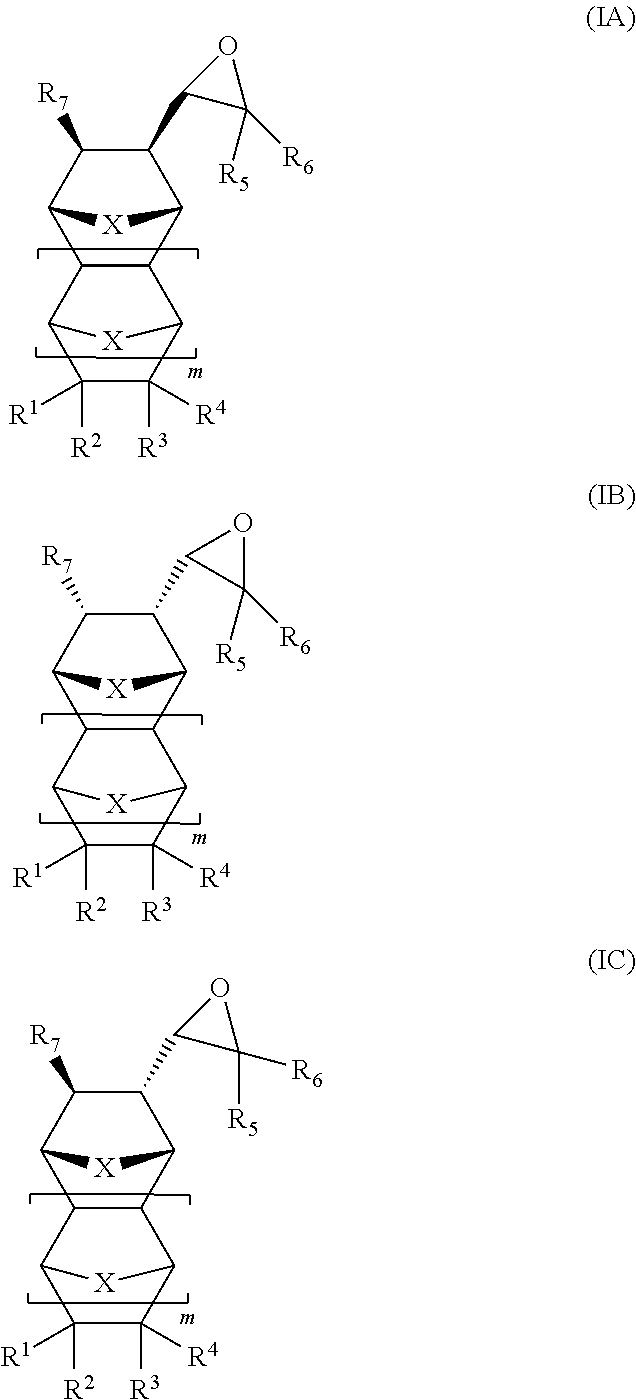High glass transition temperature photoimageable polycarbonate polymers with pendent polycyclic functional groups
a polycyclic functional group and high glass transition temperature technology, applied in the field of polycarbonate polymers, can solve the problems of inability to achieve high-temperature baking conditions. achieve the effect of improving pattern fidelity, reducing polymer flow issues, and increasing glass transition temperatur
- Summary
- Abstract
- Description
- Claims
- Application Information
AI Technical Summary
Benefits of technology
Problems solved by technology
Method used
Image
Examples
example 1
[0160]The polymerization was conducted with no solvent at the beginning. Dichloromethane was added after the reaction mixture solidified.
[0161]A magnetic stirring bar, (R,R)-(salcy)CoOBzF5 (13.2 mg, 0.0162 mmol) and PPNCl (9.3 mg, 0.0162 mmol) were placed in an appropriately sized stainless autoclave and the autoclave was sealed under nitrogen atmosphere. exo-NBaneOx (4.0 mL, 32.4 mmol) was added to the autoclave via glass syringe, and then CO2 was pressurized into the autoclave at 1.3 MPa and the mixture was stirred in a 22° C. water bath. Small amount samples were taken out by a syringe and needle after depressurized the autoclave for monomer conversion and molecular weight measurement (table 2). The reaction mixture was found solid at day 5. Dichloromethane (40 mL) was added at day 7 to dissolve the solidified reaction mixture. The reaction was stopped by releasing CO2 at day 13, and the reaction solution was transferred to an appropriate size flask. The solvent was stripped by r...
example 2
[0163]A sample from Example 1 was used as macro-initiator. The reaction was conducted without solvents.
[0164]A magnetic stirring bar, (R,R)-(salcy)CoOBzF5 (13.2 mg, 0.0162 mmol) and PPNCl (9.3 mg, 0.0162 mmol), RA134 (3.55 g) were placed in an appropriately sized stainless autoclave and the autoclave was sealed under nitrogen atmosphere. exo-NBaneOx (4.0 mL, 32.4 mmol) was added to the autoclave via glass syringe, and then CO2 was pressurized into the autoclave at 1.3 MPa and the mixture was stirred in a 22° C. water bath. Small amount samples were taken out at day 2, 4, and 14 for GPC measurement (table 2). The reaction was stopped by releasing CO2 at day 18, and a brown viscous liquid was transferred to a beaker and chloroform was then added to the liquid to be 80 mL. The solution turned green after an addition of 20 mL of hydrochloric acid 5% methanol solution. This greenish solution was stirred for 10 minutes and the solvents were stripped by rotary evaporator to reduce the volu...
examples 3-6
[0166]Four batches of polymers were combined to precipitate since the four reactions gave similar molecular weights.
PUM
| Property | Measurement | Unit |
|---|---|---|
| Temperature | aaaaa | aaaaa |
| Glass transition temperature | aaaaa | aaaaa |
| Glass transition temperature | aaaaa | aaaaa |
Abstract
Description
Claims
Application Information
 Login to View More
Login to View More - R&D
- Intellectual Property
- Life Sciences
- Materials
- Tech Scout
- Unparalleled Data Quality
- Higher Quality Content
- 60% Fewer Hallucinations
Browse by: Latest US Patents, China's latest patents, Technical Efficacy Thesaurus, Application Domain, Technology Topic, Popular Technical Reports.
© 2025 PatSnap. All rights reserved.Legal|Privacy policy|Modern Slavery Act Transparency Statement|Sitemap|About US| Contact US: help@patsnap.com



